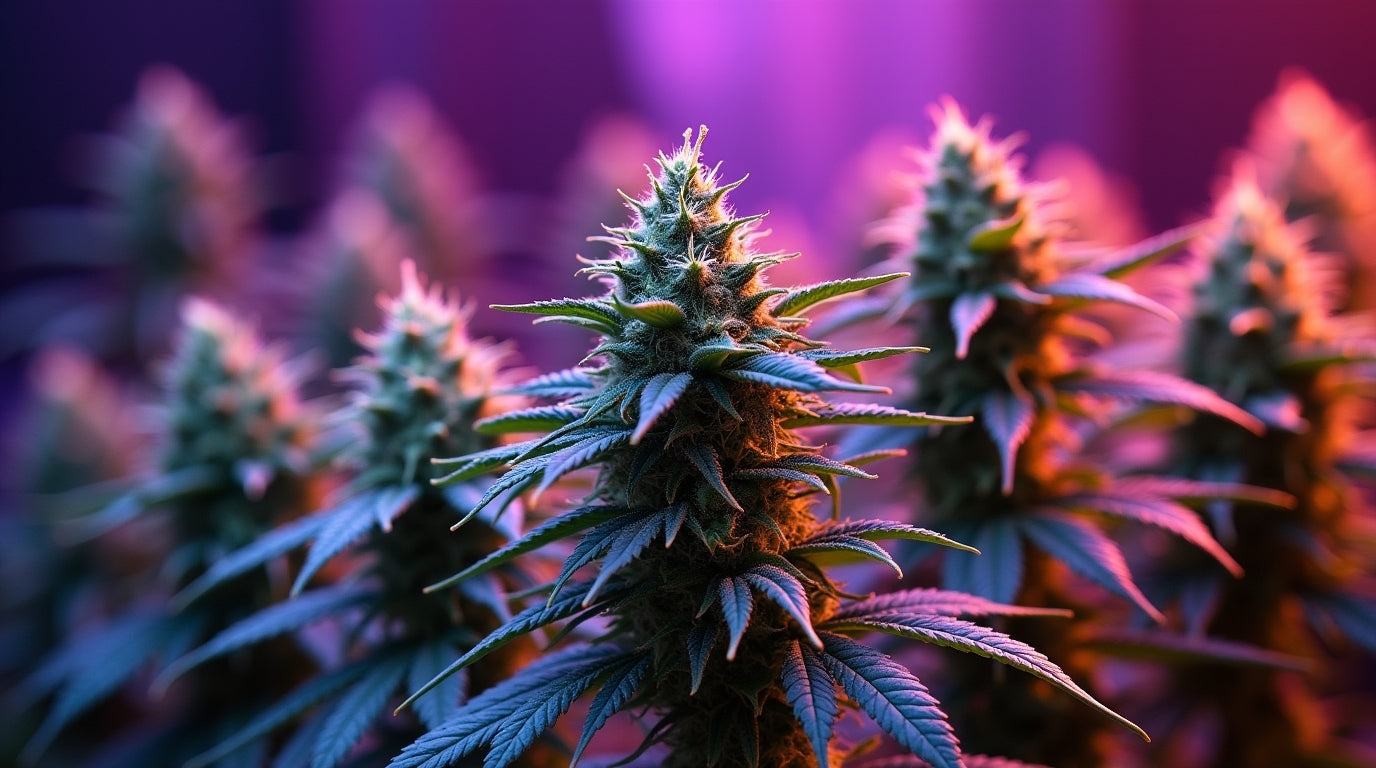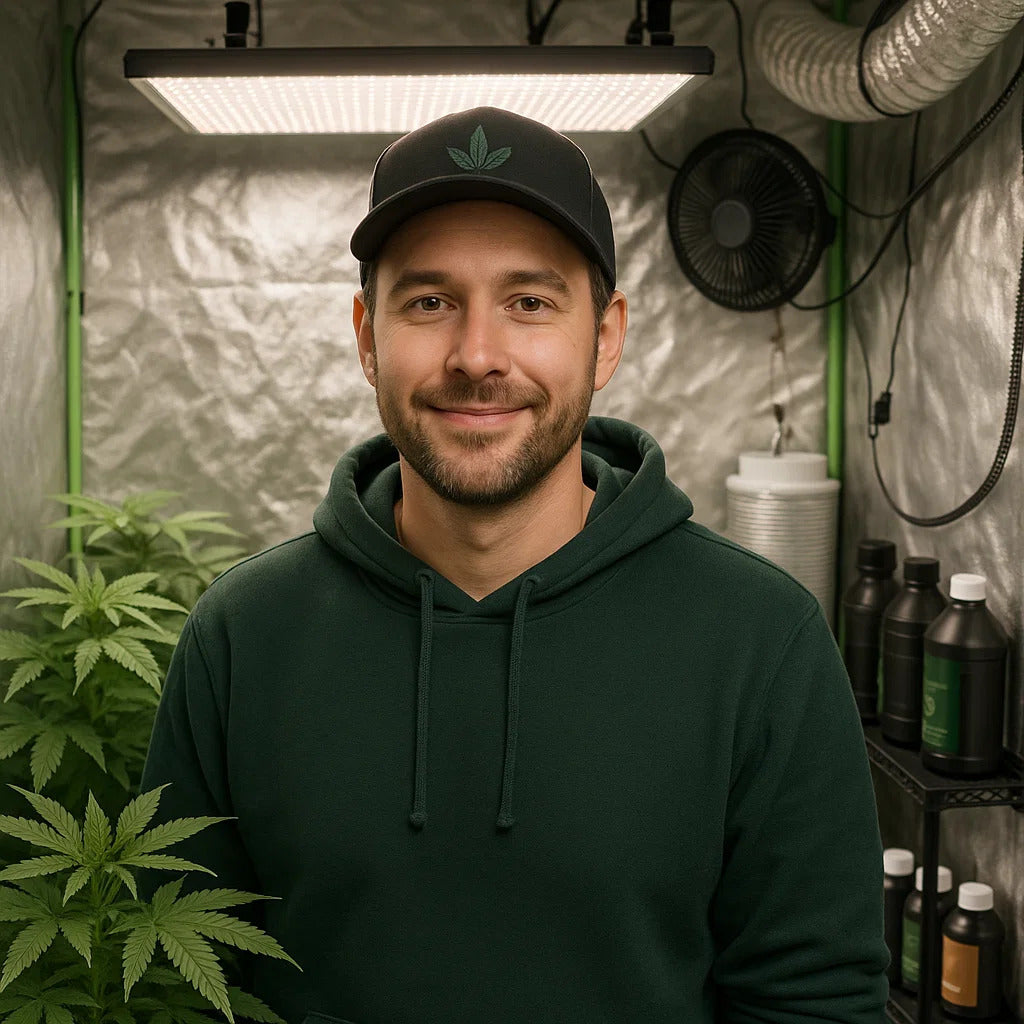
How to Grow a Weed Plant: Your Complete Single Plant Cultivation Journey
Learning how to grow a weed plant successfully starts with understanding that cannabis cultivation is both an art and a science. Whether you're a complete beginner interested in growing your first plant or someone looking to perfect single-plant techniques, mastering the fundamentals of cannabis cultivation creates a foundation for producing premium-quality flowers with exceptional potency and flavor.
Growing a single weed plant offers several advantages for beginners: lower initial investment, easier management, focused attention on plant health, and the ability to learn cultivation principles without overwhelming complexity. Many experienced growers still prefer single-plant grows for experimenting with new genetics or perfecting advanced techniques.

Choosing Your First Cannabis Plant
Seed Selection for Beginners
Autoflowering vs. Photoperiod Strains: Autoflowering varieties automatically transition from vegetative growth to flowering regardless of light schedules, making them ideal for beginners. Photoperiod strains require specific lighting changes to trigger flowering but offer more control over plant size and timing.
Indica-Dominant Varieties: These strains typically remain shorter and bushier, making them perfect for limited space and easier management in small grow tents. They also generally have shorter flowering periods.
Beginner-Friendly Genetics: Look for strains described as "easy to grow," "forgiving," or "resilient" that can tolerate minor environmental fluctuations and beginner mistakes.
Feminized Seeds: Choose feminized seeds to ensure your plant will be female and produce flowers rather than pollen. Male plants don't produce the desired flowers and can pollinate females if not removed.
Understanding Plant Size Requirements
A single cannabis plant can vary dramatically in size depending on genetics, growing techniques, and environmental conditions. Indoor plants typically range from 2-6 feet in height, with some sativa strains growing even taller without proper training techniques.
Container Size Impact: Larger pots allow bigger root systems and larger plants, while smaller containers naturally limit plant size. For single plants, 3-7 gallon containers work well for most indoor grows.
Training Techniques: Methods like Low-Stress Training (LST) and topping can keep plants compact while increasing yields, making them perfect for single-plant grows in limited spaces.
Essential Equipment for Growing One Weed Plant
Compact Grow Tent Setup
For growing a single weed plant, you don't need massive equipment, but quality remains crucial for success. Small grow tent systems provide everything needed for successful single-plant cultivation while maintaining professional growing standards.
2x2 Grow Tent Benefits:
- Perfect size for one well-trained plant
- Complete environmental control
- Easy to manage and maintain
- Fits in closets, spare rooms, or basements
- Professional results in minimal space
Equipment Integration: Quality grow tents come with pre-installed mounting points for lights, fans, and training equipment, making setup straightforward even for beginners.
Lighting Requirements for Single Plants
LED Lighting Advantages: Modern LED lights provide full-spectrum lighting while generating minimal heat, making them ideal for small spaces and single-plant grows.
Light Coverage: For one plant, 100-300 watts of quality LED lighting typically provides adequate coverage, depending on plant size and training techniques.
Adjustable Height Systems: Gorilla Grow Tents feature adjustable height extensions, allowing you to accommodate plant growth and maintain proper light distances throughout the growing cycle.
Ventilation and Environmental Control
Air Exchange: Even single plants require proper ventilation for healthy growth. Inline fans and carbon filters manage odor while providing fresh air circulation.
Temperature Control: Maintain temperatures between 70-80°F during lights-on periods and 65-70°F during lights-off periods for optimal growth.
Humidity Management: Control humidity levels to prevent mold and mildew while supporting healthy plant development through different growth phases.
Step-by-Step Growing Process
Week 1-2: Germination and Seedling Stage
Germination Methods: Start seeds using paper towel method, starter plugs, or direct soil planting. Maintain warm, humid conditions around 70-80°F for successful germination.
First Leaves: Once cotyledon leaves appear, provide gentle lighting about 24-36 inches away to prevent burning delicate seedlings.
Watering Technique: Use spray bottles or small amounts of water to keep soil moist but not waterlogged. Overwatering is the most common mistake at this stage.
Environmental Conditions: Maintain high humidity (60-70%) and stable temperatures to support healthy seedling development.
Week 3-8: Vegetative Growth Phase
Rapid Development: During vegetative growth, your plant will develop its main structure, branches, and leaf systems. This is when size control and training techniques are most effective.
Lighting Schedule: Maintain 18-24 hours of daily lighting to keep plants in vegetative growth. Many growers use 18/6 schedules to save electricity while maintaining healthy growth.
Nutrient Introduction: Begin feeding with nitrogen-rich vegetative nutrients, starting with quarter-strength solutions and gradually increasing based on plant response.
Training Implementation: Start Low-Stress Training (LST) by gently bending branches to create even canopy heights and expose more growing sites to direct lighting.

Week 9-12: Pre-Flowering and Transition
Lighting Change: For photoperiod strains, switch to 12 hours of light and 12 hours of complete darkness to trigger flowering. Autoflowering strains transition automatically.
Gender Identification: Watch for pre-flowers to confirm your plant is female. Female plants show white pistils, while males develop pollen sacs.
Environmental Adjustments: Gradually reduce humidity to 40-50% as flowering begins to prevent mold and mildew development.
Nutrient Transition: Switch to flowering nutrients with higher phosphorus and potassium content while reducing nitrogen levels.
Week 13-20: Flowering Development
Flower Formation: Watch as your plant develops flowers that will gradually swell and develop resin throughout the flowering period.
Environmental Stability: Maintain consistent temperature, humidity, and lighting schedules as flowering plants are more sensitive to environmental stress.
Support Systems: As flowers develop weight, branches may need support using plant stakes, trellises, or tie-downs to prevent breaking.
Monitoring Progress: Observe flower development, resin production, and pistil color changes to determine optimal harvest timing.
Nutrition and Feeding Your Single Plant
Understanding Cannabis Nutrition Needs
Macronutrients: Nitrogen (N), Phosphorus (P), and Potassium (K) form the foundation of plant nutrition, with different ratios needed during vegetative and flowering phases.
Vegetative Feeding: Higher nitrogen ratios (like 3-1-2 NPK) support leafy growth and structural development during the vegetative phase.
Flowering Feeding: Lower nitrogen with higher phosphorus and potassium (like 1-3-2 NPK) supports flower development and resin production.
pH Management: Maintain soil pH between 6.0-7.0 or hydroponic pH between 5.5-6.5 for optimal nutrient uptake.
Feeding Schedule and Techniques
Start Small: Begin with quarter-strength nutrient solutions and gradually increase based on plant response and manufacturer recommendations.
Feeding Frequency: Most soil grows require feeding every 2-3 waterings, while hydroponic systems may need daily feeding with weaker solutions.
Plant Response Monitoring: Watch for signs of nutrient deficiency or excess, adjusting feeding programs based on leaf color and overall plant health.
Flush Period: Stop feeding nutrients 1-2 weeks before harvest, using only pH-adjusted water to improve flavor and smoothness.
Training Techniques for Maximum Single Plant Yields
Low-Stress Training (LST) Methods
Bend and Tie Technique: Gently bend main branches outward and secure with soft ties to create an even canopy that exposes more bud sites to direct lighting.
Gradual Adjustment: Make small adjustments every few days rather than dramatic changes that could stress or damage your plant.
Equipment Needed: Use soft plant ties, training wire, or LST clips designed specifically for cannabis training without cutting into stems.
Advanced Training Options
Topping Technique: Remove the main growing tip to encourage two main branches, creating a bushier plant with multiple main colas.
FIMing Method: Pinch or cut approximately 75% of the newest growth tip to encourage multiple new growth points without the stress of complete topping.
Screen of Green (SCROG): Use horizontal screens to train branches evenly and maximize light penetration throughout the canopy.
Recovery Time: Allow 3-7 days of recovery after high-stress training techniques before implementing additional training methods.
Managing Growth Stages and Timing
Vegetative Stage Management
Growth Control: Use training techniques and container size to control plant size while maximizing yield potential within your available space.
Branch Development: Encourage horizontal growth and multiple main branches to create more flowering sites for increased yields.
Leaf Management: Remove large fan leaves that block light penetration to lower bud sites, but avoid excessive defoliation that can stress plants.
Flowering Stage Optimization
Environmental Consistency: Maintain stable conditions as flowering plants are more sensitive to temperature, humidity, and lighting fluctuations.
Support Installation: Install plant supports before flowers become heavy enough to bend or break branches under their own weight.
Monitoring Development: Track flower development progress and watch for signs of maturity to determine optimal harvest timing.

Common Problems and Solutions
Environmental Issues
Temperature Stress: High temperatures cause leaf curl and reduced growth, while low temperatures slow development. Use ventilation and heating/cooling to maintain optimal ranges.
Humidity Problems: High humidity encourages mold and mildew, while low humidity reduces growth rates. Use dehumidifiers or humidifiers as needed.
Light Burn: Too much light or lights too close cause leaf bleaching and stress. Adjust light distance and intensity based on plant response.
Nutrient and Watering Issues
Overwatering: Most common beginner mistake causing root rot and stunted growth. Allow soil to dry between waterings and ensure proper drainage.
Nutrient Burn: Excessive feeding causes leaf tip burning and dark green foliage. Reduce nutrient concentrations and increase watering frequency.
Deficiency Signs: Yellowing leaves, slow growth, or discoloration indicate specific nutrient deficiencies requiring targeted feeding adjustments.
Pest and Disease Prevention
Preventive Measures: Maintain clean growing environments, inspect plants regularly, and quarantine any new plants or equipment before introduction.
Common Pests: Watch for spider mites, aphids, thrips, and fungus gnats that can damage plants and reduce yields significantly.
Organic Solutions: Use neem oil, beneficial insects, or organic pesticides to manage pest problems without harmful chemical residues.
Harvesting Your Single Plant
Determining Harvest Timing
Trichome Examination: Use jeweler's loupes or digital microscopes to examine trichome color and development for optimal harvest timing.
Pistil Color Changes: Monitor pistil color changes from white to amber as another indicator of flower maturity and harvest readiness.
Strain-Specific Timing: Different genetics have different flowering periods, typically ranging from 7-12 weeks depending on variety and growing conditions.
Harvest Process and Techniques
Preparation: Prepare drying space with controlled temperature (60-70°F), humidity (45-55%), and gentle airflow before harvesting.
Cutting Technique: Use clean, sharp scissors to harvest plants, either whole or in sections depending on drying space and preferences.
Initial Trimming: Remove large fan leaves and trim excess leaf material while preserving sugar leaves that contain valuable cannabinoids.
Drying and Curing Process
Drying Phase: Hang harvested plants in controlled environments for 7-14 days until small stems snap cleanly rather than bending.
Curing Process: Store dried flowers in sealed glass containers with 58-62% humidity for 2-8 weeks to develop optimal flavor and potency.
Quality Control: Monitor temperature, humidity, and container conditions during curing to prevent mold while developing complex terpene profiles.
Maximizing Success with Professional Equipment
Investment in Quality Systems
Long-term Value: Quality growing equipment provides consistent results through multiple growing cycles while maintaining reliability and performance standards.
Professional Features: Complete Gorilla Grow Tent systems offer superior construction, integrated ventilation, and expandable designs that accommodate growing experience and changing needs.
Beginner Advantages: Professional equipment reduces variables that cause growing problems, making success more achievable for first-time growers.
Scaling for Future Growth
Expandable Systems: Choose equipment that can accommodate larger operations as experience and confidence grow over time.
Modular Design: Quality grow tent systems allow easy expansion or reconfiguration for different growing techniques and plant numbers.
Consistent Results: Professional equipment provides the environmental control necessary for repeatable success across multiple growing cycles.
Planning Your Next Growing Cycle
Learning from Experience
Record Keeping: Document growing conditions, feeding schedules, training techniques, and results to improve future growing cycles.
Strain Experimentation: Try different genetics to experience various growth characteristics, effects, and flavor profiles.
Technique Refinement: Master basic techniques before advancing to more complex growing methods and equipment configurations.
Continuous Improvement
Education Resources: Study cultivation techniques, plant biology, and growing methods from experienced cultivators and scientific sources.
Equipment Upgrades: Gradually improve equipment quality and capabilities based on experience and specific growing goals.
Community Engagement: Connect with other growers to share knowledge, troubleshoot problems, and stay current with industry developments.
Conclusion: Your Single Plant Success Journey
Learning how to grow a weed plant successfully combines scientific understanding with practical experience, attention to detail, and commitment to continuous improvement. Single-plant grows offer the perfect introduction to cannabis cultivation while providing opportunities for experimentation and skill development.
Success begins with quality equipment that provides reliable environmental control and supports healthy plant development. Gorilla Grow Tent systems offer the professional features, superior construction, and expandable design that serious cultivators need for consistent, high-quality results.
From selecting genetics and setting up equipment to harvesting and curing your first homegrown cannabis, each step in the growing process teaches valuable lessons that improve future cultivation efforts. Whether you're growing for personal use, medicinal needs, or simply the satisfaction of creating something exceptional, the journey of cultivating a single weed plant provides rewards that extend far beyond the final harvest.
The foundation for successful cannabis cultivation lies in understanding plant biology, maintaining optimal environmental conditions, and investing in quality equipment that supports your growing goals. With proper preparation, attention to detail, and commitment to learning, growing a single weed plant can produce results that rival or exceed anything available from commercial sources while providing the satisfaction that comes from creating something extraordinary with your own hands.

Lena Myles
I'm a mushroom enthusiast and home cook based in Oregon. I'm passionate about foraging and creating fungi-focused recipes, especially delicious, plant-based dishes using gourmet mushrooms like trumpet, shiitake, and oyster. When I’m not in the kitchen, you’ll usually find me wandering the woods in search of new wild flavors.


